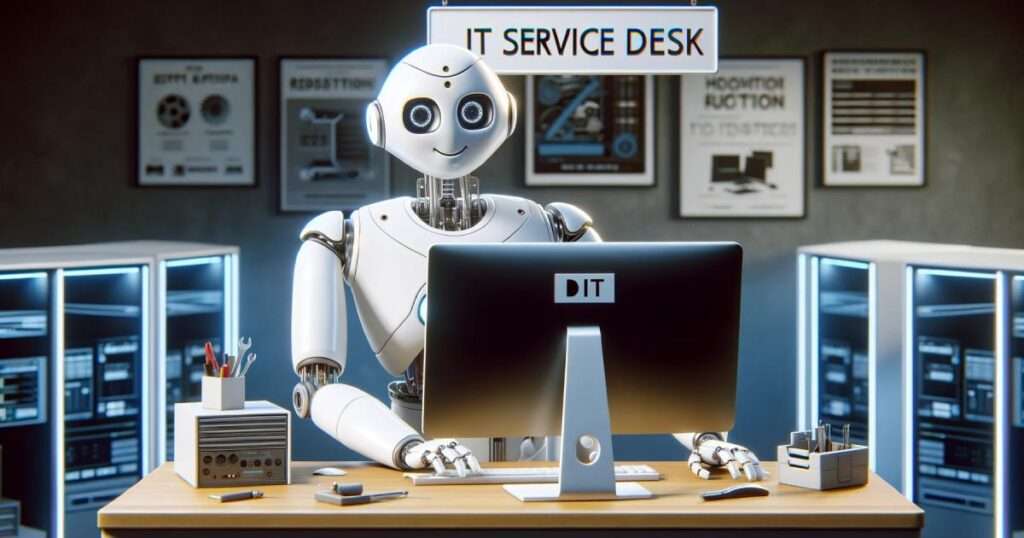Introduction to Service Desk and Help Desk
When you have an IT-heavy business, you need a support system in place. The terms “help desk” and “service desk” are often used interchangeably, but they are fundamentally different. A help desk is tactical and reactive, focused on fixing immediate break-fix issues for end-users.
A service desk is strategic and business-focused, managing the entire lifecycle of IT services to not only resolve issues but also fulfill service requests and align technology with company objectives.
What is Service Desk?
A service desk can be described as the single point of contact that handles communication or interaction between the service provider and the users. Service desks manage incidents and other service delivery requests to support business goals. It’s also designed to handle communication with users.
In other words, a service desk software is a communications hub where customers can find support from specific IT service providers. This support may include service request fulfillment, incident resolution, or some other form of problem management. But no matter how the support is provided, the service level agreements’ primary goal is to deliver fast, efficient, and reliable service to customers so issues can be resolved as quickly as possible.
Service desks focus on a variety of ITSM activities, including incident management, self-service, reporting, knowledge management, asset management, support capability, and service request management. These are robust, service-oriented departments that are built around connecting IT teams to customers to provide timely help.

What is a Help Desk?
A help desk is fundamentally a team dedicated to providing assistance, support, and solutions to users facing technical problems, errors, or any IT-related issues. Distinct from a service desk, which offers broader service management, a help desk is sharply focused on resolving immediate problems. Here’s a more detailed look at what sets a help desk apart:
Solution-Oriented Approach:
The primary mission of a help desk is to quickly and effectively resolve issues. Unlike a service desk, which aims to deliver comprehensive service to end-users, including managing service requests and broader IT service lifecycle management, a help desk zeroes in on solving specific problems. Its goal is straightforward: to fix what’s broken, promptly and efficiently.
Incident Management Focus:
Help desks specialize in incident management. This means they are the first point of contact for users experiencing technical difficulties. While service desks may handle a range of requests—from new service requests to general inquiries—help desks concentrate on troubleshooting and resolving incidents as swiftly as possible.
A Subset within a Broader Framework:
It’s helpful to think of the help desk as a component of the larger IT service support ecosystem. While it operates with a narrower focus, addressing immediate technical challenges, the service desk encompasses a wider array of support functions, including those performed by the help desk. This distinction underscores the help desk’s role in the immediate, reactive aspect of IT support, contrasting with the service desk’s proactive, service-oriented approach.
In essence, the help desk plays a critical role in ensuring users’ technical problems are addressed efficiently, emphasizing quick fixes and immediate resolution. Its contribution is vital to maintaining operational continuity and ensuring users can return to their tasks with minimal disruption.

Difference Between Help Desk vs Service Desk vs ITSM
In the realm of IT support, both help desks and service desks serve pivotal roles, yet they stem from different focuses and origins, catering to diverse needs within an organization. Understanding these distinctions is vital for selecting the most suitable IT support system that aligns with your business’s requirements.
Origins and Focuses:
A help desk is typically introduced as an additional feature within an existing IT framework, primarily aimed at addressing immediate technical issues and user concerns reactively. This setup is designed to tackle problems as they emerge, prioritizing quick fixes without necessarily integrating a broader strategic vision.
Contrastingly, a service desk is ingrained as a fundamental component of a comprehensive IT Service Management (ITSM) strategy. It is characterized by its proactive and strategic approach, focusing on the entire lifecycle of IT services. The service desk’s goal is to enhance long-term solutions and overall service quality, surpassing the mere resolution of immediate issues.
Scope and Strategies:
While both entities can manage similar tasks, the service desk typically boasts a broader scope. Beyond merely addressing immediate problems, it actively contributes to the improvement of overall IT services and processes, embedding itself as a critical element in the strategic planning of ITSM.
Survey data reflects the variability in how organizations label their support centers, with no universally agreed-upon terminology. This diversity underscores the importance of understanding the functionality and support provided for the specific name used.
Technological Enhancements:
The integration of natural language processing and conversational AI has significantly boosted the efficiency of both help desks and service desks. Adopting chatbots and Generative AI showcases the evolving landscape of IT support, enhancing the user experience and operational efficiency.
Defining the Differences:
Help Desk: A solution-oriented entity, the help desk is focused on immediate incident management, striving to resolve specific user issues quickly and effectively. It operates within a reactive framework, often lacking a broader strategic plan.
Service Desk: Serving as the strategic backbone of IT support, the service desk is designed to manage the entire IT service lifecycle. It adopts a proactive stance, aimed at not only solving immediate problems but also improving IT services and aligning IT operations with business objectives.
According to HDI research in which respondents were asked to select the term they use to describe/label their support center, these were the answers:
- Service desk (36 percent)
- Help desk (23 percent)
- Technical support (9 percent)
- IT/IS support (9 percent)
- Support center (7 percent)
- Customer support center (5 percent)
- Customer service center (5 percent)
- Call center (3 percent)
- Contact center (3 percent)
In other words, while 59 percent of respondents use one of the two terms highlighted in this article, 41 percent use a different term. This indicates that there’s no real, concrete, agreed-upon definition in place. Instead, each organization seems to choose its terminology. This means it’s less about the term and more about the support that’s provided.
Today, service and help desks increasingly use natural language processing and conversational AI to improve their efficiency. The use of chatbots for IT helpdesk, and we can find many use cases of Generative AI in IT support.
Now, let’s dive into the definitions of each IT solution for a better understanding of the help desk, service desk tools, and ITSM.
Which One Is Right for You, Service Desk or Help Desk?
When evaluating the fundamental differences and the respective service desk capabilities and help desk platforms, it’s important to understand their unique focal points. Specifically, the Help Desk is designed with a user-centric orientation, acting as a digital troubleshooter.
User-Centric and Business-Centric Approaches
This IT support entity, showcasing the capabilities of service desks, is ready to jump into action when an end user encounters technical hitches. Be it a malfunctioning application, an unresponsive system, or software bugs, the Help Desk solution always ensures a seamless tech experience for users by quickly addressing and resolving these immediate issues.
In contrast, the typical Service Desk adopts a business-centric viewpoint, serving as the comprehensive manager of an organization’s IT infrastructure. Beyond just tackling immediate technical problems, the Service Desk is the strategic conductor of IT services, operating by IT Service Management principles.
It plays a proactive role, focusing on the planning and execution of IT services promptly that align with the broader business goals. As a single point of contact for all IT-related concerns, the Service Desk is instrumental in driving business success through effective IT service management processes.
How ITSM Help IT Service Desk?
Before we get too deep into the weeds of help desks vs service desks, let’s get clear on another term that’s important to know: ITSM Stands for IT service management. ITSM is an acronym used to describe how a company’s IT team manages the service lifecycle and the end-to-end delivery of IT services to customers. This includes a variety of activities and processes involved in the ideation, creation, design, delivery, and support of IT services.
While ITSM solutions are often confused with IT-related tasks alone, it’s truly more than this. The ITSM team is responsible for more than just basic IT support. They handle everything having to do with workplace technology, including servers, laptops, devices, and business-critical applications. Next-gen ITSM solutions, which are powered by artificial intelligence, significantly help IT departments.
How to Build the Right Support System for the Service Requests
As you can see, the difference between service desks and help desks is very nuanced. You might even have trouble recognizing the key differences between these two different “desks” after reading the explanations above. If that’s the case, don’t be discouraged. (You’re not alone.)
If you want to set your business up well, focus less on terminology and more on the value you’re providing. Your goal is to solve issues as quickly as possible and provide the support that all end users and stakeholders need to be successful. Whether you call it service desk support, service desk services, automated help desk, support center, or some other clever name, it doesn’t matter. What’s important is that you have the right tools and infrastructure in place.
Autonomous Systems in IT Support
The future of IT support is moving from a reactive help desk to a strategic service desk, and Agentic AI is accelerating this shift. This AI works as an autonomous agent, proactively monitoring IT environments to predict and resolve complex issues without human intervention. Enabling self-healing and Agentic AI in ITSM turns the service desk is turned from a place that just fulfills requests into an intelligent, value-driven powerhouse that prevents disruptions and is way better than the break-fix model.
Conclusion
One of the best AI-powered IT support features is its ability to deeply integrate with AI knowledge management systems and existing collaboration apps to ensure all structured and unstructured content is converted for something we call “autonomous knowledge resolution.” This basically means Aisera can tap into any existing content and leverage it for the purpose of further providing advanced services and other support capabilities.
Would you like to learn more about how you can create exceptional employee and customer experiences while simultaneously reducing customer service issues and costs so that your business is able to run as smoothly as possible? We’ll be happy to show you the ins and outs of our platform so that you can feel confident integrating it into your business. Request a tailored AI demo today!


